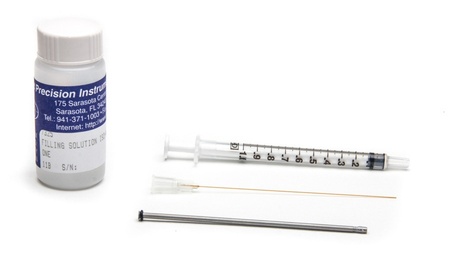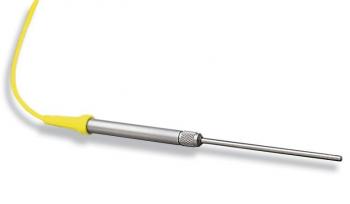ISO-HPO-2 Hydrogen Peroxide Macro Sensor
The WPI hydrogen peroxide macrosensor is used to determine the H2O2 concentration in cell cultures.
- Overview
- Specifications
- References
- Links
The amount of hydrogen peroxide in biological samples can be directly measured quantitatively.
Key features
- Blocks liquids, ions, and particulates with a gas permeable polymer membrane sleeve.
- Integrated reference electrode
- For use with Apollo1000, Apollo4000, TBR4100 and TBR1025
- Package of 1
Applications
- Cell Cultures
NOTE: The 10 mL of filling solution, 1 cc syringe, MF28G67 MicroFil needle, and spare membrane sleeve for the 2mm biosensors are also included.

Despite this oxidant's well-known significance in biology, real-time measurements at low concentrations have proven challenging. With direct quantitative detection in biological samples in the near nM range, the hydrogen peroxide sensors created by WPI are intended to supplement existing high sensitivity fluorescence techniques.
A 2.0 mm stainless steel sensor called the ISO-HPO-2 has internal electrolyte that can be refilled (100042) and removable membrane sleeves (600012). It is intended for use in cell cultures and related procedures.
The ISO-HPO-100 is a hydrogen peroxide microsensor with a 100 µm tip diameter intended for use in tissues and related applications. In order to improve H2O2 detection, the design is based on a platinum wire sensing electrode coated with a special membrane.
These sensors use WPI's unique combination electrode technology, in which a single Faraday-shielded probe design houses both the hydrogen peroxide sensing element and a separate reference electrode. It has been demonstrated that this approach decreases overall sensor size while improving measurement performance.
WPI's hydrogen peroxide (H2O2) sensors are compatible with the free radical analyzers TBR4100 and TBR1025.
Hydrogen Peroxide in Biological Systems
In biological systems, hydrogen peroxide is created by controlled processes in low quantities that affect cell signaling. Inflammatory cells produce localized, concentrated levels of this oxidant to destroy infections at larger concentrations. Uncontrolled hydrogen peroxide production from the mitochondrial respiratory chain and enzymes like xanthine oxidase can happen as human disease progresses (Prof. Victor Darley-Usmar, Univ. of Alabama, personal communication).
The instrument was used in these investigations:
- Catalase as a sulfide-sulfur oxido-reductase: An ancient (and modern?) regulator of reactive sulfur species (RSS).
Olson, K. R., Gao, Y., DeLeon, E. R., Arif, M., Arif, F., Arora, N., & Straub, K. D.
(2017). Redox Biology, 12, 325??“339. - A case of mistaken identity: are reactive oxygen species actually reactive sulfide species?
DeLeon, E. R., Gao, Y., Huang, E., Arif, M., Arora, N., Divietro, A., ??¦ Olson, K. R.
(2016). American Journal of Physiology-Regulatory, Integrative and Comparative Physiology, 310(7), R549??“R560 - Angiopreventive versus angiopromoting effects of allopurinol in the murine sponge model.
Orellano, L. A. A., Almeida, S. A., Campos, P. P., & Andrade, S. P.
(2015). Microvascular Research, 101, 118??“126.
You can also visit site of the manufacturer.


